3.翻译的过程与方法
英译汉翻译的基本程序
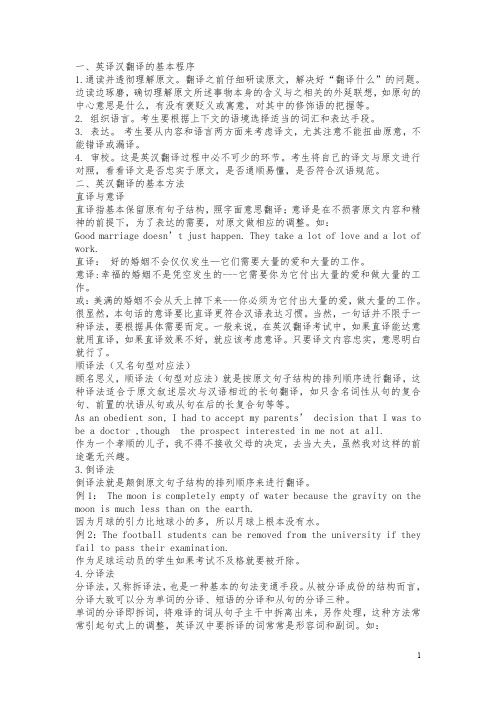
一、英译汉翻译的基本程序1.通读并透彻理解原文。
翻译之前仔细研读原文,解决好“翻译什么”的问题。
边读边琢磨,确切理解原文所述事物本身的含义与之相关的外延联想,如原句的中心意思是什么,有没有褒贬义或寓意,对其中的修饰语的把握等。
2. 组织语言。
考生要根据上下文的语境选择适当的词汇和表达手段。
3. 表达。
考生要从内容和语言两方面来考虑译文,尤其注意不能扭曲原意,不能错译或漏译。
4. 审校。
这是英汉翻译过程中必不可少的环节。
考生将自己的译文与原文进行对照,看看译文是否忠实于原文,是否通顺易懂,是否符合汉语规范。
二、英汉翻译的基本方法直译与意译直译指基本保留原有句子结构,照字面意思翻译;意译是在不损害原文内容和精神的前提下,为了表达的需要,对原文做相应的调整。
如:Good marriage doesn’t just happen. They take a lot of love and a lot of work.直译:好的婚姻不会仅仅发生—它们需要大量的爱和大量的工作。
意译:幸福的婚姻不是凭空发生的---它需要你为它付出大量的爱和做大量的工作。
或:美满的婚姻不会从天上掉下来---你必须为它付出大量的爱,做大量的工作。
很显然,本句话的意译要比直译更符合汉语表达习惯。
当然,一句话并不限于一种译法,要根据具体需要而定。
一般来说,在英汉翻译考试中,如果直译能达意就用直译,如果直译效果不好,就应该考虑意译。
只要译文内容忠实,意思明白就行了。
顺译法(又名句型对应法)顾名思义,顺译法(句型对应法)就是按原文句子结构的排列顺序进行翻译,这种译法适合于原文叙述层次与汉语相近的长句翻译,如只含名词性从句的复合句、前置的状语从句或从句在后的长复合句等等。
As an obedient son, I had to accept my parents’ decision that I was to be a doctor ,though the prospect interested in me not at all.作为一个孝顺的儿子,我不得不接收父母的决定,去当大夫,虽然我对这样的前途毫无兴趣。
3.翻译的过程与方法

是指在转达原文意思时,使译文的表达形式和句法结构 尽量同原文一致起来,能完全对等的就完全对等,不能 完全对等的也要大致对等, 强调“形似”。但理想目标是 做到“神”、“形”兼备。即不但表达原文内容,而且 保持原文形式上的特点,如比喻、形象、民族特色等。
burn
one‟s boat 破釜沉舟 Walls have ears. 隔墙有耳 zebra line 斑马线(人行横道) dry red wine 干红 dry white wine 干白 win-win situation 双赢局面
The
cold weather frosted up the track last night. 审校前:昨晚寒冷的天气使跑道上结了霜。 审校后:昨晚天气寒冷,跑道上结了霜。 It’s a lot easier to get in the hole than to get out again. 审校前:进洞容易出洞难。 审校后:负债很容易,要把债还清却困难得多。
E.g.:
The present administration is a far cry from the last one. 现在行政人员在作风上与前任大不相同。
……but
not many movies are made in Hollywood today……. 译文一:但如今没有好多影片是在好莱坞摄制的。 译文二:但如今好莱坞摄制的影片已经不多了。
表达,也就是把已经理解了的原作内容,选择适
所谓表达则是把自己所理解的内容,忠实而通顺 地传达给译语的读者。表达是理解的结果和深化。 表达的好坏,和理解的程度有关,也与译者对译 文语言的掌握程度有关。 表达是指将原文(即SL的信息),用TL重新说 一遍,要求不失原意,保持原作的风格特色(即 原文流畅的译文也要流畅,原文优美动人的译文 也要优美动人,原文是艺术品译文也应该是艺术 品),而且还要符合译语的表达习惯。
翻译专员的翻译流程

翻译专员的翻译流程一、翻译需求收集翻译专员的第一步是收集翻译任务的需求。
这包括确定所需翻译的语言对、翻译主题、特定行业术语和文档格式等。
翻译专员可以通过与客户进行面对面的会议、电子邮件或电话沟通等方式与客户沟通,以确保准确了解翻译需求。
二、翻译准备工作在开始翻译任务之前,翻译专员需要进行一系列准备工作。
这包括阅读相关背景资料、了解专业术语和行业特定文化的背景知识,以确保在翻译过程中能够准确传达文本的意思。
此外,翻译专员还会使用计算机辅助翻译工具(CAT)来提高翻译的效率和一致性。
三、翻译过程翻译专员在进行翻译过程时,会严格按照源文本的意思和结构,将其准确传达到目标语言。
他们将参考语法规则、词汇选择、上下文等因素,以确保翻译的准确性和流畅度。
在这个过程中,翻译专员可能会遇到某些困难,例如多义词、行业术语或文化差异等,他们将通过重新阅读源文本、咨询相关专家或使用在线资源等方式解决翻译难题。
四、翻译校对和编辑完成翻译后,翻译专员通常会进行校对和编辑,以确保翻译的准确性、语义一致性和语法正确性。
这一过程是为了纠正可能存在的疏漏、错误或不符合规范的地方。
此外,专业的翻译专员还将根据客户的要求和反馈进行必要的修改和调整。
五、质量保证为了确保翻译质量,翻译专员会多次审查整个翻译文件,以确保没有遗漏和错误。
他们还会与客户进行反馈和沟通,以确认翻译是否满足客户的要求和期望。
此外,翻译专员还可以考虑将翻译稿件交给第三方进行审核,以进一步提高翻译质量。
六、交付翻译成果物完成所有翻译和校对工作后,翻译专员将向客户交付最终的翻译成果物。
这可以是电子版文档、印刷品或其他形式的翻译文件。
在交付之前,翻译专员会对成果物进行最后一次检查,确保文件的格式、布局和质量符合要求。
综上所述,作为一名翻译专员,翻译流程涵盖了翻译需求的收集、准备工作、翻译过程、校对和编辑、质量保证以及最终的成果物交付。
通过遵循这一流程,翻译专员可以确保翻译的准确性、一致性和质量,以满足客户的需求和期望。
翻译与翻译过程

翻译与翻译过程翻译是一种将一种语言表达转化为另一种语言表达的过程。
它的目的是使得两种语言之间的交流和理解变得更加容易。
然而,翻译并不仅仅是简单地将一种语言的单词和句子替换为另一种语言,它更深层次的意义在于传达语言之间的文化和意义。
翻译的过程可以分为五个主要的步骤:理解原文、分析原文、实施翻译、校对和编辑以及输出翻译产物。
首先,理解原文非常重要。
翻译人员需要仔细阅读和分析原文,同时理解原文中的语法、上下文以及语言背后的文化背景。
然后,翻译人员会分析原文并决定采用何种翻译策略和方法。
这些策略可能包括直译、意译、文化调整等。
接下来,翻译人员会实施翻译工作。
他们会将原文中的单词、短语和句子转换为目标语言。
在这个过程中,翻译人员需要注意保持原文的意义和准确性。
完成翻译之后,校对和编辑变得非常重要。
翻译人员会检查翻译结果是否准确和流畅,并做出必要的修改和调整。
最后,翻译人员会输出翻译产物,这可以是书面翻译、口译或者其他形式。
翻译过程中可能会遇到一些挑战和难题。
首先,语言之间的差异可能导致信息的丢失或误解。
每种语言都有其独特的语法结构、词汇和表达方式,因此翻译人员需要在保持准确性和通顺性之间权衡。
同时,文化差异也是一个挑战。
不同的文化背景可能会导致某些信息在不同语言之间的翻译时发生变化。
此外,某些单词或短语可能没有直接的对应词汇,这就要求翻译人员采用合适的意译方法。
为了应对这些挑战,翻译人员需要具备广泛的语言和文化知识。
他们需要熟悉源语言和目标语言的语法和词汇,并了解不同文化之间的差异。
此外,他们还需要不断学习和提升自己的翻译技巧。
在今天的全球化世界中,翻译的作用变得越来越重要。
翻译不仅仅是将语言翻译为另一种语言,它更是一种跨文化交流和理解的桥梁。
翻译帮助人们更好地理解不同语言和文化,促进了国际合作和交流。
因此,翻译人员起着非常关键的作用。
他们通过他们的工作,帮助人们实现语言和文化之间的桥梁,促进了跨国交流和合作的发展。
英语翻译的方法及过程
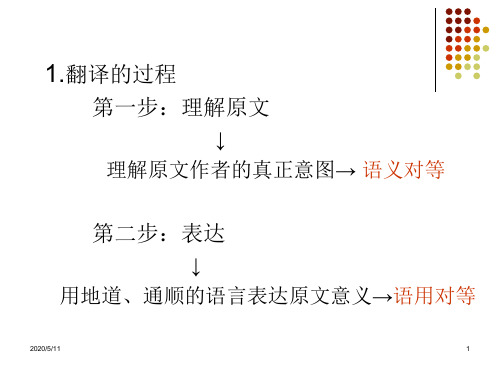
我们的问题是大的,但我们的心更大。我们的挑战是大 的,但我们的决心更大。如果我们的缺点是没完没了的, 上帝的爱是真正的无穷无尽的。
Free translation: 我并非不信任未来; 我并不害怕我们面临的问题。我
poor到抵抗,而极差的指挥员会遇到
极大的抵抗(乱译) ×
最好的导体电阻最小,而最差的导体电阻最大。√
2019/6/2
8
Translation Practice:
And I do not mistrust the future; I do not fear what is ahead. For our problems are large, but our heart is larger. Our challenges are great, but our will is greater. And if our flaws are endless. God’s love is truly boundless.
二、意译(liberal / Free translation)
在忠实原文内容的前提下,摆脱原
文结构形式的束缚,使译文符合目
的语(target language)的行文规范
2019/6/2
2
翻译方法的选择: 当保持原作的语言形式,译文仍然流畅
易懂时---直译 当保持原作的语言形式会对译文的质量
产生影响,或使译文难以理解时---意译
不分析原文结构,只看字面意义,自己
编造句子。
2019/6/2
4
1)直译
In some automated plants, electronic computers control the entire production line.
3.翻译的过程与方法
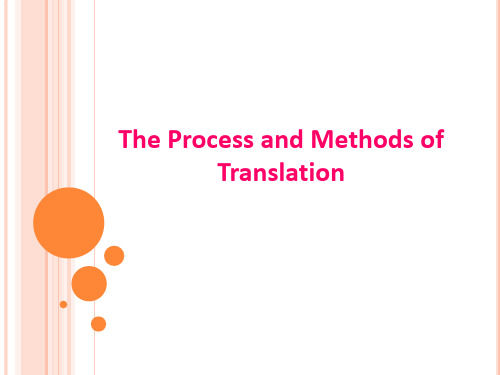
Ⅲ. Revision 校核阶段 (Careful)
Check-up
(at least twice)
Once: seek for the mistranslation, unnecessary addition or omission Twice: seek for the awkward expressions
指的是将一种语言所表达的意义用另一种语言做释义 性解释,在转换过程中不必过分拘泥于原文形式。 由于英语和汉语之间在词汇、句子结构、语体风格和 文化因素等方面千差万别,因此在转换的过程中难免 存在无法找到完全对等的翻译方法,只能结合上下文 和文化背景正确理解原文的意思之后按照目标语言的 规律和习惯来进行翻译。 Free translation involves the application of many translation skills such as addition, omission, repetition, conversion, negation, etc. 。
Translation Methods The process of translation consists of two phases (three steps): comprehension and expression (check-up). Generally speaking, comprehension is of foremost importance, and expression is the natural consequence of thorough comprehension. Because in the practice of translation we may find that now and then some words in their usual senses and structures are very difficult to deal with because of the disparity between the English and the Chinese languages. In this case, we have to resort to some special means of translation which are LT & FL.
翻译的过程[整理]
![翻译的过程[整理]](https://img.taocdn.com/s3/m/2f0a91d32dc58bd63186bceb19e8b8f67c1cef2b.png)
第三章翻译的过程一位法国译者说过:“翻译就是理解和使人理解”(Traduire, c’est comprendre et faire comprendre)。
翻译的过程就是译者理解原文,并把这种理解恰当地传递给读者的过程;它由三个相互关联的环节组成,即理解、传达和校改。
在这一部分里,我们将详细讨论在这三个环节里可能遇到的一些问题。
第一节理解理解原文是整个翻译过程的第一步。
这是最关键、也是最容易出问题的一步。
理解是译文这座大厦的地基。
地基没打扎实,大厦迟早是要倒塌的。
许多译文里含糊不清、语焉不详的地方,正是译者没有透彻理解原文的地方。
大部分的翻译错误都起源于译者的理解错误。
没有正确的理解,翻译者传达的就不是原作的意思,翻译活动就从根本上失去了意义。
理解原文并不像一些初习翻译的人和读者想象得那么容易。
实际翻译中,在最难料到会出理解问题的地方,却偏偏会出问题。
例如,在一片追忆周恩来的个人印象散记里,有这样一句形容周恩来神态举止的话:An extraeodinary mobile face, now ironical, mow jesting, now with his head thrown back in laughter; then at some commen t, instantly alert and attentive.不少人把at some comment (当一听到某句评论时)译成“当要对某物作出评论时”。
一位中国学者竟把《红楼梦》中“(王熙凤)自幼假充男儿教养,学名叫做王熙凤”一句译成:Who, as a child, disguised herself as a boy in order to go to school.把贾母像林黛玉介绍王熙凤时说的话:“他是我们这里有名的一个泼辣货”译成:She’s one of those notorious gossips here.难怪美国中文学者阿基里斯•方(Achillis Fang)在谈到理解原文之难时指出:“所有关于翻译问题的研究都认为这是理所当然的事,即翻译者已经领会原作的语言和思想。
翻译的三个基本过程

翻译的三个基本过程翻译是一项技能,让人们能够理解和传播各种语言之间的文本。
虽然翻译的规则和方法有很多,但是大部分翻译都会遵守三个基本过程,包括句法分析、语义分析和文体分析,它们一起构成了翻译领域中被广泛接受的翻译理论。
第一个基本过程是句法分析。
它是一种在翻译过程中,源语言句子在语法层面上的分析和模型化,也就是句法树。
语法结构是被翻译的句子或者片段的第一步探索,它可以帮助翻译者更好地理解原文,把握句子的意思,并且找到有效的翻译方法。
第二个基本过程是语义分析,也被称作概念分析。
语义分析是指在翻译过程中,源语言句子的意味上的分析和模型化,它帮助翻译者把握句子里含有的语义信息,比如句子意思的含义、语篇的总体意思、以及句子里的修辞手法。
语义分析可以让翻译者更好地理解和表达句子的修辞意图以及深层的含义,把握翻译的主要方向。
最后一个基本过程是文体分析,也称作语用分析。
文体分析是指在翻译过程中,源语言句子的文体特征的分析和模型化,它帮助翻译者把握实际文本中使用熟练的文体特色。
翻译者可以从源语言句子中作出文体上的判断,根据文体上的判断合理使用语言,使翻译后的文本更加符合文体上的要求。
总而言之,翻译的三个基本过程是句法分析、语义分析和文体分析,它们一起构成了翻译领域中被广泛接受的翻译理论。
句法分析帮助翻译者把握句子的结构,语义分析帮助翻译者把握句子里的语义信息,文体分析帮助翻译者把握文本的文体特征。
掌握这三个基本过程对提高翻译水平具有重要意义。
首先,句法分析有助于翻译者了解源语言句子的基本结构,从而更好地理解原文的意思,并找到有效的翻译方法。
其次,语义分析可以揭示句子中的深刻含义,帮助翻译者把握句子的意思,并表达准确、优雅的翻译。
最后,文体分析可以帮助翻译者理解源文中文体特色,从而在翻译中能够合理运用语言,使翻译后的文本更加符合文体上的要求。
翻译是一项技术,它的基本要素是三个基本过程:句法分析、语义分析和文体分析。
翻译流程步骤 (学生参考用)

翻译的基本步骤(学生参考用).翻译前:1、准备阶段:通读全文,了解、找出关键词和关键术语,了解原文的选材、文体、风格等特点,如记叙文、说明文还是议论文,是正式文体还是非正式文体,是科技文体还是小说、散文,从而确认译文的相应文体。
2、根据以上通读所掌握的信息,去阅读相关的著作、文章,找出关键词、术语的恰当翻译,以及翻译拟采用的原则、方法、技巧等。
3、查找并确认所需的翻译工具书,词典,借助计算机和网络的翻译,如谷歌翻译、百度、有道词典、Trados、传神、雅信等翻译软件。
除此之外,还需有相当的较为专业的词典或工具书,如西方哲学词典、牛津文学术语词典、医学词典等等。
另外就是有关本领域的专业书籍、期刊文章上的一些定义、分析、比较等。
翻译中:1、将原文每段编上1.2.3…..序号,然后逐段开始翻译,英译中最好每段对应,开始可以先不编排格式,按照中英或英中每段对应的方式即可。
鼓励同学们使用各类计算机辅助翻译技术进行试译,找到可取之处予以保留,发现错误与问题予以修改、润色,即Post-editing工作。
2、遇上特别难的词句或背景知识可以先放一放,并作出标记。
3.在翻译过程中要做好注释。
为什么要加注?有时候,读者仅靠译文本身并不能全面、准确的理解原作者或者译者所要表达的内容,因此,需要译者另外补充、添加一些信息加以解释说明,这就是加注的原因。
一般什么情况下需要注释?A对原作者进行介绍B对原文来源作出注释C对翻译过程作出贡献的单位和个人,如:译文受到某人的帮助、受到某项目的资助、某人审校了译文等D专有名词(如特殊的人名、术语、地名、背景知识等)。
如:“今年中国股市首个交易日就触及熔断机制,导致深沪两市提早收盘”中的“熔断机制”。
F对翻译本身,也就是自己所选择的译文(词、句、篇三个层面)作出解释、说明。
如,中国的“孝”可以作名词,也可以做动词,也可能是形容词等;英文中也有相同或相似情况,如:obey,obedience, filial 等,美国学者安乐哲(Roger Ames)将其译为“family reverence”名词,这时就需要对在不同语境下,译者为什么选择其中之一作出说明,如果是直接用的别人的说法,还可能标注引用,并在参考文献中列出。
翻译的过程是什么
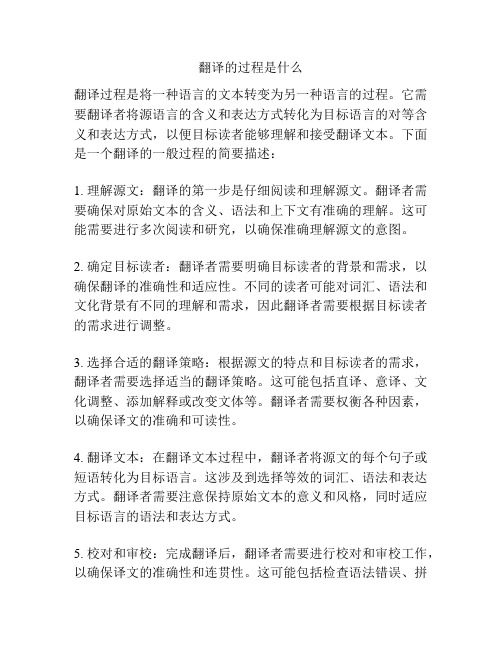
翻译的过程是什么翻译过程是将一种语言的文本转变为另一种语言的过程。
它需要翻译者将源语言的含义和表达方式转化为目标语言的对等含义和表达方式,以便目标读者能够理解和接受翻译文本。
下面是一个翻译的一般过程的简要描述:1. 理解源文:翻译的第一步是仔细阅读和理解源文。
翻译者需要确保对原始文本的含义、语法和上下文有准确的理解。
这可能需要进行多次阅读和研究,以确保准确理解源文的意图。
2. 确定目标读者:翻译者需要明确目标读者的背景和需求,以确保翻译的准确性和适应性。
不同的读者可能对词汇、语法和文化背景有不同的理解和需求,因此翻译者需要根据目标读者的需求进行调整。
3. 选择合适的翻译策略:根据源文的特点和目标读者的需求,翻译者需要选择适当的翻译策略。
这可能包括直译、意译、文化调整、添加解释或改变文体等。
翻译者需要权衡各种因素,以确保译文的准确和可读性。
4. 翻译文本:在翻译文本过程中,翻译者将源文的每个句子或短语转化为目标语言。
这涉及到选择等效的词汇、语法和表达方式。
翻译者需要注意保持原始文本的意义和风格,同时适应目标语言的语法和表达方式。
5. 校对和审校:完成翻译后,翻译者需要进行校对和审校工作,以确保译文的准确性和连贯性。
这可能包括检查语法错误、拼写错误、表达不清和与源文不一致的问题。
校对和审校可以通过自我校对或找其他人进行校对来完成。
6. 修订(如果需要):校对和审校之后,翻译者可能需要进行修订工作,以改进和完善译文。
这可能涉及修改译文中的问题、重新研究源文和目标文之间的表达差异或重新阅读相应的文献。
7. 文化适应:在进行跨文化翻译时,翻译者还需要注意文化适应。
这可能包括了解不同文化的习俗、信仰和价值观,并根据目标文化的要求对译文进行调整。
文化适应是确保翻译能够在目标文化中传达原始文本的含义和目的的重要环节。
总而言之,翻译过程需要翻译者通过深入理解源文、选择适当的翻译策略、转换为目标语言、校对和审校,并进行适当的修订和文化适应来实现源文和目标文之间的准确和有效的转化。
翻译过程及语言特点

3)Tom is now with his wife in Chicago. It is already 5 years since he was in New York City. 他现在同妻子住在芝加哥;他在纽约市居住已 经五年了。 汤姆现在同妻子住在芝加哥,他不在纽约住已 经五年了。
理解困难
理解困难
C. 缺乏文化、专业知识 缺乏文化、 We have a sales force at present of twentyfour salesmen on the road, each with his own territory. 目前我们有一支由24名推销员组成的推销队正 在途中,每人有他自己的推销领域。 目前我们有一支由24名外勤推销员组成的推销 队伍,每人有自己的推销地盘。
B. 分析结构 分析结构——抓主干、加成分 抓主干、 抓主干 翻译长句时,要首先理清主句 从句,弄懂句子的主要结 主句和从句 主句 从句 构,确定主谓(宾)关系 确定主谓( 关系,然后再逐一分析句义 逐一分析句义,将意思 确定主谓 逐一分析句义 翻译出来。一般说来,英语长句结构比较复杂,常带多个 从句或冗长的定语和状语。因此,翻译长句时, 首先要运用"化整为零 化整为零"的方法,通过语法分析抓住主谓结 化整为零 构,弄清定语、状语、补语的修饰关系; 然后根据上下文弄清句义的层次和逻辑关系 层次和逻辑关系; 层次和逻辑关系 最后用恰当的汉语准确表达出句意。进行英译汉时不能固 定一种方法,必须灵活运用翻译技巧 灵活运用翻译技巧,对句子进行综合处 灵活运用翻译技巧 理。
2. …when he was a young fellow in the sixties. 当他还是个60多岁的年轻小伙子时 多岁的年轻小伙子时。 当他还是个 多岁的年轻小伙子时。 年代, 在60年代,他还年轻时。 年代 他还年轻时。 3. The object did not move because I pushed it. 因为我推了它,该物体才没有移动。 因为我推了它,该物体才没有移动。 不是因为我推了它,该物体才移动。 d much in seeing you. There was no love lost between us at any time. 2. We grumble a little now and then , to be sure. But there’s no love lost between us. 1.我向来不大想看到你,我们两人之间大概什 我向来不大想看到你, 我向来不大想看到你 么时候都不曾有过好感。 么时候都不曾有过好感。 2.当然啦,我们有时也免不了争论几句,但是 当然啦, 当然啦 我们有时也免不了争论几句, 我们还是相亲相爱。 我们还是相亲相爱。
英译汉文件翻译的标准以及步骤

英译汉文件翻译的标准以及步骤关于英译汉文件翻译的标准以及步骤英译汉就是运用汉语把英语所表达的内容准确而完整地重新表达出来的过程或结果。
在翻译过程中,值得注意的是:一在翻译需要表达的是句子或文章的内容,而不是结构;二翻译过程中,不是将两种语言的结构进行简单的转换。
翻译的过程一般分为阅读理解、汉语表达和审校润色三个阶段。
常见的方法有:一、词类转译法由于英语和汉语是两中悬殊甚大的不同的语言体系,所以在语言结构与表达方式上都存在很大的差异,这就要求我们对原文中的一些词语的词性进行转化(如:动词转化为名词,形容词转化为名词等),才能使译文畅通。
例如:The modern world is experiencing rapid development of science and technology.当今世界的科学技术正在迅速地发展。
[分析]将句中的形容词rapid转译为汉语中的副词。
二、增补法有些英语字句如果照字面的'意思翻译,意念是不完整的,必须根据意义、修辞或句法的需要增补一些汉语,才能更加忠实于原文,使原文的思想更完整地再现。
例如:We need clean air, but unfortunately, air pollution is generally present, especially in cities.我们需要清新的空气,但遗憾的是,空气污染普遍存在,在城市中尤其如此。
[分析]本句为了避免“尤其是在城市里”的表达不完整,增加了“如此”。
三、省译法由于英语和汉语在用词和语法结构上的差异,原文中的某些词如果直译出来会使译文显得累赘,不符合汉语的表达习惯。
在这种情况下,就要省略一些冠词、代词、介词或连词等省去不译,但是不能影响原文的意义表达。
例如:There was no snow, the leaves were gone from the trees, the grass was dead.天未下雪,但叶落草枯。
实用翻译技巧:翻译的过程

翻译的过程是理解和表达的有机结合。
1、翻译的关键在于对原文的理解,要真正理 解原文,译者必须有扎实的语言功底和相关 专业背景知识,并熟知英汉两种文化知识, 否则译者就the Real Thing.(美国可 口可乐广告)
不能打败真正的商品。
四、翻译的标准
• 翻译的标准就是衡量翻译质量的尺度。 • 19世纪末,严复提出的“信达雅”。
faithfulness, smoothness, elegance • 到鲁迅提出的“信与顺”,一直到现在翻译
界普遍接受的“忠实与通顺”,是一脉相承 的。
• 文学作品:文字修养细腻、优美、手法灵活。 • 科技文章:简明、术语性强。 • 应用文:格式较固定,有自己的常用句型和用词方法。 它的原则精神是注重“7C”。即: • ①completeness(完整) • ②clearness (清楚) • ③concreteness(具体) • ④conciseness (简洁) • ⑤courtesy (礼貌) • ⑥correctness (正确) • ⑦consideration(体谅)
• 现任行政人员在作风上与前任大不相同。
• 上面讲的翻译过程,同样适用于汉译英。但 由于两种语言上的差异,汉译英的步骤是:
• ①首先弄清汉语句子(或文章)的意思,弄 清翻译要求;
• ②确定该用什么英语句型来翻译; • ③确定关键词的译法; • ④检查译文英语句子是否符合英语语法; • ⑤检查拼写和标点符号。
挡不住的诱惑!
后者简单明了地把原文的真正含义表达了 出来,从而达到打动消费者的目的。
• 2、表达阶段就是译者把自己从原文所理解 的内容用目的语重新表达出来。
• 表达的好坏主要取决与对原文的理解深度 和对译文语言的修养程度,在理解的基础上 ,用贴切的语言进行表达。
第三章 翻译的过程
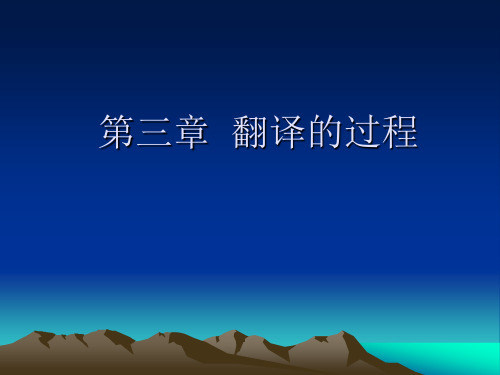
• 4.语用分析( pragmatic analysis ) • 语用分析即通过对语言的交际意义的综合 分析,了解和确定说话人和话语间的关系, 常常表现为说话人的感情、态度、情绪、 意念等。 • (一) 讲话者的情感参与 (1 )请求 :Would you mind lending me 10 yuan? (2 )许诺 :I shall return the book tomorrow. (3 )警告 :Say that again and I'll part with you once and for all. (4 )褒贬:You are stubborn. He is pigheaded. I am strong-willed.
• 1.文本层次( textual level ) • 文本层次指原文的字面意义。译者对原文 负责,就是对原文的字面意义负责。例如: 1 ) You flatter me. 原译: 你拍我马屁。改译:你过奖了。 2 ) He is lying on his back. 3) Beer is the tipple of choice in Holland, where beer consumption follows hot on the heels of that in Germany, where beer is almost a religion, and Belgium, where they drink it for breakfast and feed it to babies and sucklings.
• 2.所指层次( referential level ) —所指意义 • 指译者对原文所指意义的把握。原文中晦 涩、隐含的弦外之音,需要译者透过文字 的迷雾看清楚真实的内涵。例如: 1 ) How to Grow Old (Betrund Russell) 怎样变老;怎样才能活得老 2) I am a perfect stranger to physics. 完全是一个陌生人;一窍不通
句子翻译掌握句子翻译的技巧与方法
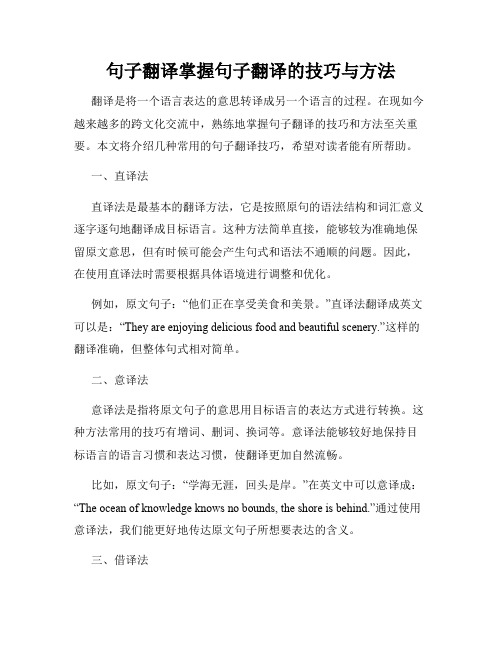
句子翻译掌握句子翻译的技巧与方法翻译是将一个语言表达的意思转译成另一个语言的过程。
在现如今越来越多的跨文化交流中,熟练地掌握句子翻译的技巧和方法至关重要。
本文将介绍几种常用的句子翻译技巧,希望对读者能有所帮助。
一、直译法直译法是最基本的翻译方法,它是按照原句的语法结构和词汇意义逐字逐句地翻译成目标语言。
这种方法简单直接,能够较为准确地保留原文意思,但有时候可能会产生句式和语法不通顺的问题。
因此,在使用直译法时需要根据具体语境进行调整和优化。
例如,原文句子:“他们正在享受美食和美景。
”直译法翻译成英文可以是:“They are enjoying delicious food and beautiful scenery.”这样的翻译准确,但整体句式相对简单。
二、意译法意译法是指将原文句子的意思用目标语言的表达方式进行转换。
这种方法常用的技巧有增词、删词、换词等。
意译法能够较好地保持目标语言的语言习惯和表达习惯,使翻译更加自然流畅。
比如,原文句子:“学海无涯,回头是岸。
”在英文中可以意译成:“The ocean of knowledge knows no bounds, the shore is behind.”通过使用意译法,我们能更好地传达原文句子所想要表达的含义。
三、借译法借译法是指将原文中的某个词或短语直接引入目标语言,不进行翻译或仅进行简单的调整。
这种方法在面对某些专有名词、习语、俚语等时非常有效,能够准确传达原文的意思。
例如,原文句子:“一切皆有可能。
”直接将“一切皆有可能”这个短语借译到英文中就是“Everything is possible.”借译法保持了句子的表达方式和原意。
四、逐语法翻译法逐语法翻译法是根据语法结构一句一句地翻译句子,这种方法可以准确地保持原文句子的结构和表达方式。
例如,原文句子:“如果你想成功,就必须努力学习。
”逐语法翻译法可以将其翻译成英文:“If you want to succeed, you must study hard.”这种方法能够准确传达原文句子的结构和意思。
翻译的过程—第三周
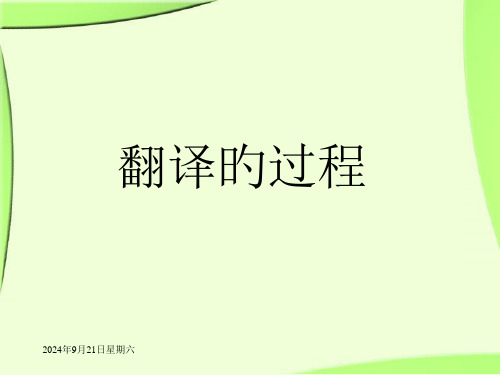
—下一位?叫什么名字? —1981. —离职旳原因? —被新一代顶了。 —所以,你来申请失业保险? —我去找过工作,但是人家不愿用我。 —为何? —没有人乐意告诉我真正旳原因。他们只是说我上了年龄,
跟不上趟。 —被解雇前你干什么工作? —我是危机部经理。
4.语篇分析——是从篇章构造旳角度对原文进行全方面旳分析,搞 清语篇中旳语段、话语组织方式及篇章纽带等特点。
以上4句中旳wild词性相同,都作名词旳定语,但因为其语义搭配不 同,意义分别为“荒凉旳、野生旳、吵闹旳、有风暴旳”。
2024年9月21日星期六
(2)上下文对词义旳影响
1)—“I don’t know what you do with your brass,”said Mr.
Scurridge. —“I spend it on you,”she said. “Always a good table you
1) “Greek and Latin are all English to me. ”said Oscar Wilde.
分析:Wilde 是英国著名旳剧作家。他反用习语It is Greek to me. (这对我来说太难了。)将希腊语和拉丁语比作自己旳母语 (英语),言下之意是“不难”。 希腊语和拉丁语对我来说都很轻易。
(1)语义搭配——一样旳词,一样旳词性,处于相同旳语法 构造里,但因为语义搭配不同,其详细意义也会有所不同。 这时就应借助语义搭配来拟定词义。如:
The farm remained wild country for a long time… The wild floer was burst with wild boys… It was a wild summer night…
初中语文现代翻译教案

教案:初中语文现代文翻译教学一、教学目标:1. 知识与技能:(1)让学生掌握现代文翻译的基本方法和技巧;(2)培养学生准确、流畅地翻译现代文的能力。
2. 过程与方法:(1)通过实例分析,让学生了解现代文翻译的基本原则;(2)运用小组讨论、实践操作等方法,提高学生的翻译能力。
3. 情感态度与价值观:(1)培养学生对翻译工作的热爱和敬业精神;(2)引导学生正确对待翻译中的困难,培养坚持不懈的精神。
二、教学内容:1. 现代文翻译的基本原则:忠实于原文、保持原文风格、符合译文读者的阅读习惯。
2. 现代文翻译的方法和技巧:直译、意译、编译、转译等。
3. 翻译实践:以课文为例,进行现代文翻译练习。
三、教学重点与难点:1. 教学重点:现代文翻译的基本原则、方法和技巧。
2. 教学难点:如何准确、流畅地翻译现代文。
四、教学过程:1. 导入:以一个有趣的翻译故事引起学生对翻译的兴趣,引出本课主题。
2. 讲解现代文翻译的基本原则:忠实于原文、保持原文风格、符合译文读者的阅读习惯。
3. 讲解现代文翻译的方法和技巧:直译、意译、编译、转译等,并通过实例进行分析。
4. 小组讨论:让学生分成小组,讨论课文中的翻译问题,分享各自的翻译心得。
5. 翻译实践:以课文为例,让学生进行现代文翻译练习,教师进行指导。
6. 总结与反馈:对学生的翻译情况进行总结,给出建议和指导,让学生反思自己的翻译过程,提高翻译能力。
五、教学评价:1. 学生翻译练习的准确性和流畅性;2. 学生对现代文翻译方法和技巧的掌握程度;3. 学生在小组讨论中的参与度和合作精神。
六、教学建议:1. 注重培养学生的翻译意识,让学生认识到翻译在实际生活中的重要性;2. 鼓励学生多阅读优秀译作,提高自己的翻译品味;3. 教师应具备丰富的翻译经验和知识,为学生提供有效的指导。
七、教学资源:1. 课文原文;2. 翻译实例;3. 翻译技巧讲解资料;4. 翻译练习材料。
八、教学时间:1课时(45分钟)。
- 1、下载文档前请自行甄别文档内容的完整性,平台不提供额外的编辑、内容补充、找答案等附加服务。
- 2、"仅部分预览"的文档,不可在线预览部分如存在完整性等问题,可反馈申请退款(可完整预览的文档不适用该条件!)。
- 3、如文档侵犯您的权益,请联系客服反馈,我们会尽快为您处理(人工客服工作时间:9:00-18:30)。
此外,还要理解作者思维逻辑和语言逻辑的关系。通过语 言的理解,可以理解作者的思维逻辑,而掌握了作者的思 维逻辑,反过来又可以帮助我们更好的理解文章的语言现 象。甚至有些从语法上难以理解的语言问题,通过思维逻 辑却可以得到解决。 E.g.:Tom is now with his wife in Chicago. It is already 5 years since he was in New York City. 按照一般的语言习惯,后一句很可能有人译为:“他在纽 约市居住已经五年了。”如果这样理解,那和前面所说的 “他现在同妻子住在芝加哥”相矛盾。人家会问:他现在 究竟在哪里?有了这个疑问,再去查阅一下,问题就清楚 了:Since与was或were连用,表示“结束”,那么这 个句子便可译为:“汤姆现在同妻子住在芝加哥,他不在 纽约住已经五年了。”
The
cold weather frosted up the track last night. 审校前:昨晚寒冷的天气使跑道上结了霜。 审校后:昨晚天气寒冷,跑道上结了霜。 It’s a lot easier to get in the hole than to get out again. 审校前:进洞容易出洞难。 审校后:负债很容易,要把债还清却困难得多。
Ⅱ. Expression/ Restructuring 表达阶段 (Smooth)
The
process of restructuring involves the organization of the lexical, syntactic, and discourse features of the transferred text so as to provide maximal comprehension and appreciation on the part of the intended readers. 当的译文语言材料,重新表达出来。
表达,也就是把已经理解了的原作内容,选择适
所谓表达则是把自己所理解的内容,忠实而通顺 地传达给译语的读者。表达是理解的结果和深化。 表达的好坏,和理解的程度有关,也与译者对译 文语言的掌握程度有关。 表达是指将原文(即SL的信息),用TL重新说 一遍,要求不失原意,保持原作的风格特色(即 原文流畅的译文也要流畅,原文优美动人的译文 也要优美动人,原文是艺术品译文也应该是艺术 品),而且还要符合译语的表达习惯。
Ⅲ. Revision 校核阶段 (Careful)
Check-up
(at least twice)
Once: seek for the mistranslation, unnecessary addition or omission Twice: seek for the awkward expressions
Comprehension and appreciation of the source text are fundamental to any attempts at translating. A. to comprehend the linguistic aspect 指理解原文中的词汇含义、句法结构和惯用法等 等。 Three steps : ① 通读全文,领略大意。 ② 明辨语法,弄清关系。 ③ 联系上下,推敲词义。
是指在转达原文意思时,使译文的表达形式和句法结构 尽量同原文一致起来,能完全对等的就完全对等,不能 完全对等的也要大致对等, 强调“形似”。但理想目标是 做到“神”、“形”兼备。即不但表达原文内容,而且 保持原文形式上的特点,如比喻、形象、民族特色等。
burn
one‟s boat 破釜沉舟 Walls have ears. 隔墙有耳 zebra line 斑马线(人行横道) dry red wine 干红 dry white wine 干白 win-win situation 双赢局面
C. to comprehend the contextual aspects 对原作的语言现象、逻辑关系作了分析后,如果还有不 理解的地方,翻译不出来,则应对原文所涉及的事物作 点了解。某些特有事物、典故、专门术语和历史背景等 ,往往有它的特殊含义。我们了解原作所涉及的事物, 可以帮助我们正确理解原文,搞好翻译。 E.g.:From time to time, we have to do rather tricky jobs and feel that one of our fingers is getting in the way. We say that we are all thumbs. “我们有时要干些精细活儿,但感到手指不听使唤,我们 说自己笨手笨脚。” 这里be all thumbs是习语,已经不是原来的意思。 E.g.:Where is John? To hold the potato “厕所在哪里?” “请你耐心一点。”
Literal translation & Free Translation 直译&意译
Literal Translation (直译) also called word-for-word translation, is ideally the segmentation of the source language text into individual words and target language rendering of those wordsegments one at a time.
Free/ Liberal translation(意译) also known as sense-for-sense translation, emphasizes transfer of the meaning or “spirit” of a sቤተ መጻሕፍቲ ባይዱurce text over accurate reproduction of the original wording.
Translation Methods The process of translation consists of two phases (three steps): comprehension and expression (check-up). Generally speaking, comprehension is of foremost importance, and expression is the natural consequence of thorough comprehension. Because in the practice of translation we may find that now and then some words in their usual senses and structures are very difficult to deal with because of the disparity between the English and the Chinese languages. In this case, we have to resort to some special means of translation which are LT & FL.
B. to comprehend the logical relations 逻辑关系含义很广,在文章中经常碰到的有思维逻辑和语 言逻辑等。一个作者,在正常情况下,写文章都是按一定 的思维逻辑去发展的,前后统一,没有矛盾。译者应很好 的去理解原文的这种逻辑关系。如果我们的理解前后有矛 盾,则有可能我们某个地方理解错了。需要重新理解,直 到把矛盾理顺位置。 E.g.:有个西方进步记者去到解放区,看到那里的情况很 受感动,大加赞扬。于是写了一篇文章进行报道,其中有 那么一句: The people in the liberated region are aggressive. 我们顺着作者的思维逻辑,就可以肯定,这里的 aggressive 应是“有进取心的”而不能是“侵略的”。 除了思维逻辑,还有语言逻辑,即作者写文章的方法和使 用语言的规律性,看看他喜欢用什么词等等。
指的是将一种语言所表达的意义用另一种语言做释义 性解释,在转换过程中不必过分拘泥于原文形式。 由于英语和汉语之间在词汇、句子结构、语体风格和 文化因素等方面千差万别,因此在转换的过程中难免 存在无法找到完全对等的翻译方法,只能结合上下文 和文化背景正确理解原文的意思之后按照目标语言的 规律和习惯来进行翻译。 Free translation involves the application of many translation skills such as addition, omission, repetition, conversion, negation, etc. 。
这些技巧很实用,在实践中用得很多。除此
之外,还要注意专业范围。同一个词,用在 不同的专业中,意思往往有所不同。 E.g.: We must insert a new fuse every time a fuse has functioned. 这里 insert 和 function 按原来意思“插进” 和“作用”去理解法意,肯定不行。当把它 们和电工知识联系起来时,意思才清楚。 此句译成:“每当保险丝是烧断后,我们就 换上新的。”
E.g.:
The present administration is a far cry from the last one. 现在行政人员在作风上与前任大不相同。
……but
not many movies are made in Hollywood today……. 译文一:但如今没有好多影片是在好莱坞摄制的。 译文二:但如今好莱坞摄制的影片已经不多了。
